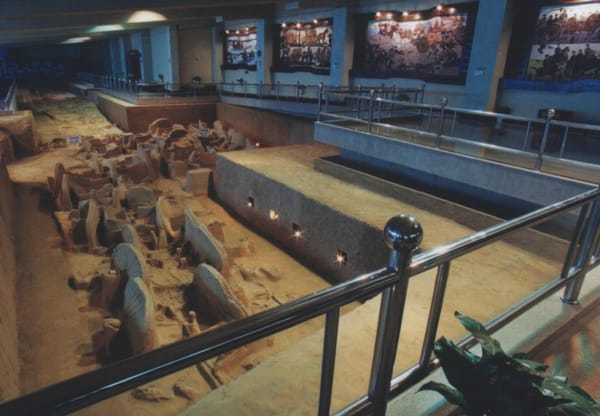Ancient DNA Findings: Insights from the Central Plains of China during the Eastern Zhou Period





The Shangshihe cemetery, nestled in Yima City, Henan Province, offers a remarkable window into the past, particularly the enigmatic Guo State—a prominent vassal state during the Western Zhou period. With the eastward migration of King Ping of Zhou, the Guo State moved east, eventually to be integrated into the Jin State. This cemetery, thought to be tied to the Guo State elite and their families, sheds light on the social structures and cultural dynamics of the time.
The Eastern Zhou period (770–256 BCE), a significant epoch in China's history, was marked by profound social changes, including increased social stratification, sustained conflicts, and striking migrations. In the heart of these transformations was the Western Guo State—a powerful vassal state that moved east during this period. The Central Plains of China, often called the cradle of Chinese civilization, played a crucial role in developing ancient societies. It's a region teeming with archaeological wonders from diverse cultures like the Peiligang, Yangshao, Longshan, and iconic dynastic cities like Erlitou and Yinxu.
The site was unearthed in two significant digs during 2017 and 2018, revealing a treasure trove of artifacts. Among the rich cultural assemblage, archaeologists found not just human remains but also horse pits, exquisite bronze vessels, delicate pottery, stunning jade artifacts, and practical stone tools. These finds draw striking parallels with known Guo State burial practices and hint at deep social stratification: larger, north-south oriented tombs often came with luxurious grave goods, suggesting the high status of the interred.
Careful excavations have revealed an astonishing array of artifacts—bronze vessels with intricate inscriptions, pottery, and jade—a testament to the affluent lives of the Guo State elites. It's not just the scale of the findings that betrays the richness of the culture; it's the details—each carefully preserved piece tells a story of artistry and rituals in a transformative era. Large and medium tombs predominantly aligned north-south, reflecting the prestigious status of their occupants, while smaller tombs oriented east-west suggest a hierarchy in burial practices.
Inscriptions on exquisite bronze vessels, undisturbed for millennia, confirm what the towering graves suggested: the prominence of the elite Guo State, thriving in a world of rich cultural exchanges. These artifacts, alongside genomic revelations, offer a rare glimpse into how these ancient peoples lived, interacted, and commemorated their dead. The dead speak to us through their accompaniments—vessels with intricate inscriptions, jades with telltale craftsmanship, and the very arrangement of the tombs at Shangshihe.
The successful retrieval of 13 ancient genomes from this cemetery paints a picture of genetic vitality among its people. Predominantly descended from the Yellow River Basin ancestry, they also show subtle signs of genetic ties to Southern East Asian and Eurasian Steppe groups. This admixture might be a testament to the vibrant trade networks and cultural exchanges that would have crossed the Central Plains, particularly during a restless era like the Eastern Zhou.
An intricate puzzle of Y-chromosome haplogroups paints a detailed picture of ancestral diversity, integrating clues about the complex past dynamics. Among the ancient individuals brought to light are carriers of notable Y-chromosome haplogroups such as C2b1b, O2a, and Q1a1a1a, each painting a vivid picture of the diverse paternal heritage. The maternal genetic canvas is equally colorful, with haplogroups like A8, B4, and D4a5 offering glimpses into the web of ancient human stories.
This genetic fabric reaffirms the role of the Central Plains as a nexus of population interplay—a crucible whence flows the seeds of a sophisticated civilization. Genomic studies reveal a distinctly dominant Yellow River-related ancestry, delicately interlaced with influences that tell a tale of far-reaching connections and vibrant cultural exchanges. Living in the shadow of legendary territories like the Yellow River basin, Shangshihe individuals primarily carried diverse maternal haplogroups typical in East Asia.
The genetic makeup of the Shangshihe populace hints at dramatic interactions over time, especially with peoples from Southern East Asia and the distant Eurasian steppe. As these interactions intensified, they left indelible marks within the DNA, reflecting the echoes of ancient relationships that crossed barriers of geography and culture. The intricate dance of genes as unveiled by advanced techniques such as admixture analysis brings to light subtle Eurasian steppe influences.
While minor, these influences signify the cross-cultural meldings that characterized much of the Eastern Zhou period. The flourishing trade routes, cultural exchanges, and possibly even warfare led to a rich tapestry of genetics, reflecting a time when people and ideas flowed freely through the Central Plains corridor. This genetic mosaic showcases the dynamics of population flow, echoing with the whispers of Southern East Asian ancestries and even subtle Eurasian Steppe influences.
Patterns of autosomal DNA present a picture of genetic homogeneity within social strata, even with distinct paternal lines. Such genetic threads, woven across tens of generations, illuminate the Yellow River Basin's central role in ancient migrations and cultural exchanges. This genetic tapestry elucidates not only the continual narrative of central and southern influences but also whispers tales of Steppes communion, all mingling within the heart of the Central Plains.
The study reveals a fascinating blend of genetic continuity and change, underscoring Central Plains as a dynamic hub of migration and interaction. These ancient individuals maintained a core genetic identity from the Yellow River Basin while engaging in far-reaching connections with the wider ancient world, supported by both archaeological and genomic analysis. The individuals from Shangshihe exhibited extensive genetic diversity—a blend from the Yellow River Basin, Southern East Asia, and the Eurasian Steppes.
Unearthed in the form of tangible artifacts and intangible genetic insights, the lives and identities of these ancient people unfold. The Shangshihe individuals show a striking genetic affinity with populations around the Yellow River, emphatically placing them at the heart of long-lasting interactions. The interwoven ancestry from the Yellow River, mingled with Southern and Steppe influences, paints a picture of societies that were vibrant and diverse.
As we delve further, the Guo State, once relocated to Sanmenxia City following its own upheavals, shines through these inquiries. Torn from their homeland, the Guo State elite appear to have mingled substantially with neighboring societies, leaving a genetic trail that speaks volumes of their resilience and adaptability during turbulent times.
The tombs at Shangshihe not only reveal more about the Guo State's elite but also connect us to the social and cultural intricacies of the Eastern Zhou period. Through the lens of genetic archaeology, we gain insight into the lives, migrations, and exchanges of a bygone era that helped lay the foundations of what would become Chinese civilization. The genetic narrative is complemented by immersive archaeological and historical tales, offering a cultural lens through which these transformations are appreciated.
The Eastern Zhou period remains a chapter of immense cultural significance, not simply marked by its social upheavals but also by the traces it left in the DNA of modern populations. The excavation at Shangshihe represents a window into a past populated by dynamic exchanges and evolving identities. As we delve deeper, these insights continue to enhance our understanding of how the ancient world sculpted the human lineage contours we visualize today.
Driven by their exceptional context, finds from the Shangshihe cemetery provide a rare window into the social intricacies and connect competing hypotheses into a harmonious timeline of historical events, giving voice to the individuals who walked the landscapes of ancient China during one of its most dynamic periods. The genetic stories from Shangshihe offer a new lens through which we view the alliances and amorphous boundaries of ancient China during transformative centuries.
This captivating tapestry of the Eastern Zhou society is further untangled through genetic studies of ancient genomes, illuminating pathways of ancient interactions driven by migration, trade, and shared cultural practices. These grave goods are more than historical curiosities; they are bookmarks of human stories, allowing us glimpses into lives lived at the cusp of societal transformation, inviting readers to immerse themselves in the interwoven stories of ancient peoples and their profound connections across regions.

Comments